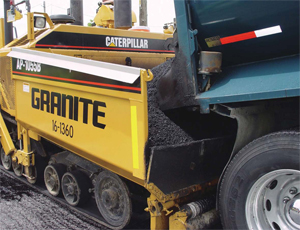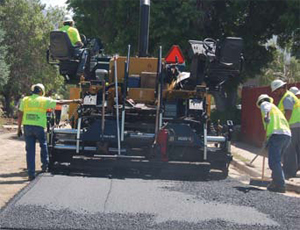Granite Construction Co. of Salt Lake City has been experimenting this past year with warm-mix asphalt in an effort to make asphalt paving more green, and ultimately more friendly to the environment.




According to Granite environmental manager Chris Faulhaber, warm-mix asphalt employs a process through which asphalt is produced, placed and compacted at lower temperatures than conventional hot-mix asphalt. Warm-mix asphalt is typically produced at temperatures that are 50 to 100 degrees Fahrenheit, lower than those used for traditional hot-mix asphalt.
“We’re trying to push an environmentally friendly product that is equal to, or better, than hot-mix,” says Faulhaber. “We haven’t been able to see the overall effects of our work this year yet, but it’s supposed to extend the paving season for compacting asphalt.”
Because warm-mix asphalt is produced and laid at cooler temperatures, the process consumes less energy and generates fewer emissions than hot-mix asphalt. Warm-mix asphalt offers other benefits such as cooler weather paving, an extended paving season and faster release of pavement to traffic.
Under current guidelines from the Utah Dept. of Transportation, the paving season for contractors runs from April 15 to October 15, when outdoor temperatures are at least 50 degrees.
“We like it – we’re encouraged by the potential benefits it brings,” says Kris Peterson, director of construction and materials for UDOT. “It has the potential to be at a lower cost. You’re not burning as much oil or natural gas to heat it, and a reduction in carbon emissions should result once they get the technology mastered. It also allows contractors to haul asphalt longer distances without getting the cooling that impacts the ability to compact it.”
有一些针对温拌沥青技术available that allow asphalt to be worked at temperatures lower than traditional asphalt. These technologies lower the viscosity of the asphalt and provide an even coating of aggregate with asphalt binder. In one approach, water injected into the asphalt binder before mixing it with stone and sand causes microscopic foam to form. The foam makes the asphalt workable at lower temperatures than those used to work hot-mix asphalt.
Recovered and crushed asphalt can be recycled into warm-mix asphalt. In fact, warm-mix asphalt may allow for higher percentages of recycled asphalt to be used while maintaining lower temperatures than would be used with hot-mix asphalt.
Warm-mix asphalt may not be suitable in all applications of road construction. Specialized equipment or admixtures are needed to produce warm-mix asphalt, and not all clients or government agencies will allow it in their current specifications.
Faulhaber says Granite has done a handful of test projects this year, including Wall Avenue south of 12th Street in Ogden, a project for Salt Lake County on 5th East from 39th South to 45th South, and a small project in Cottonwood Heights on 70th South between 16th and 17th East. It will take some time, and wear and tear of traffic, to determine how the warm-mix process measures up against the traditional hot-mix.
On the Wall Avenue project, Peterson says Granite paved half the project with a normal hot-mix asphalt mixture and the other half with warm-mix.
“We’ve done some field testing, based on national tests and our own tests,” says Peterson. “We should know by next summer if there are any issues with it.”
“We’re hoping to see some longevity and extend pavement life by not getting cracking that happens with hot-mix asphalt,” adds Faulhaber. “A typical pavement life is 15 to 20 years depending on traffic volume. We won’t have any definitive answers until after we’ve gone through the winter, and it’ll likely be a few years before telling if it will give us a longer pavement life. We think it’s an innovative technology, and one that long-term will be of great benefit to the environment.”



Post a comment to this article
Report Abusive Comment